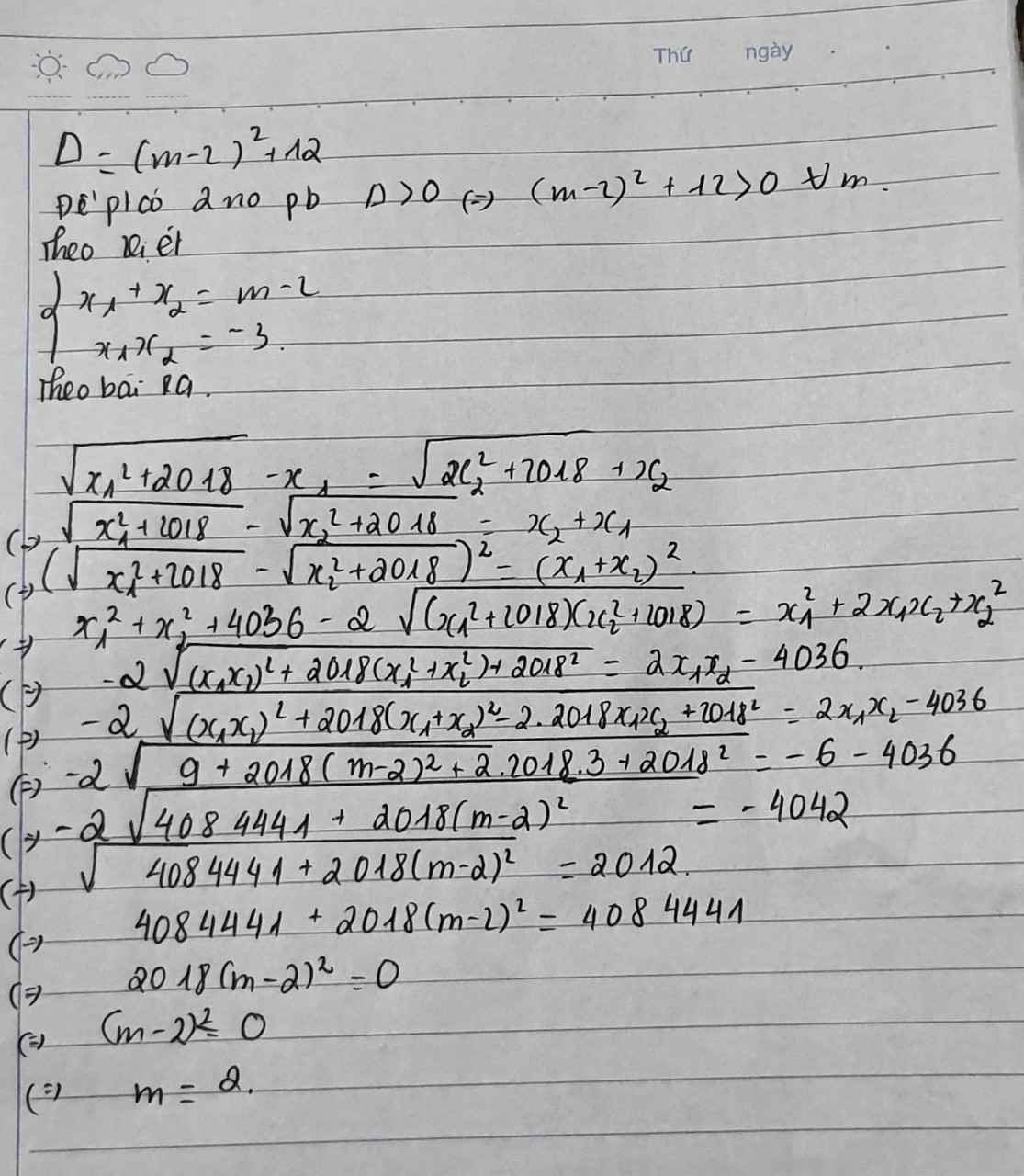Hãy nhập câu hỏi của bạn vào đây, nếu là tài khoản VIP, bạn sẽ được ưu tiên trả lời.

bạn tìm đenta
sau đó cho đenta >0
theo hệ thức viets tính đc x1+x2, x1*x2
bình phương 2 vế của pt thỏa mãn thế x1, x2 tương ứng là tìm dc m
mik chỉ nêu ý chình thôi nha mik hơi bận

\(\text{Δ}=\left(m+3\right)^2-4m^2\)
\(=m^2+6m+9-4m^2=-3m^2+6m+9\)
\(=-3\left(m^2-2m-3\right)=-3\left(m-3\right)\left(m+1\right)\)
Để phương trình có hai nghiệm phân biệt thì (m-3)(m+1)<0
=>-1<m<3
b:\(\Leftrightarrow x1+x2+2\sqrt{x_1x_2}=5\)
\(\Leftrightarrow m+3+2\sqrt{m^2}=5\)
=>2|m|=5-m-3=2-m
TH1: m>=0
=>2m=2-m
=>3m=2
=>m=2/3(nhận)
TH2: m<0
=>-2m=2-m
=>-2m+m=2
=>m=-2(loại)
c: P(x1)=P(x2)
=>\(x_1^3+a\cdot x_1^2+b=x_2^3+a\cdot x_2^2+b\)
=>\(\left(x_1-x_2\right)\left(x_1^2+x_1x_2+x_2^2\right)+a\left(x_1-x_2\right)\left(x_1+x_2\right)=0\)
=>(x1-x2)(x1^2+x1x2+x2^2+ax1+ax2)=0
=>x=0 và a=0
=>\(\left\{{}\begin{matrix}a=0\\b\in R\end{matrix}\right.\)

a: \(x^2=2\)
nên \(x\in\left\{-\sqrt{2};\sqrt{2}\right\}\)
b: \(x^2=2.5\)
nên \(x\in\left\{\dfrac{\sqrt{10}}{2};-\dfrac{\sqrt{10}}{2}\right\}\)
c: \(\sqrt{x}=3\)
nên x=9
d: \(\sqrt{x}=\sqrt{7}\)
nên x=7

Ta có: \(a-b+c=1+2m-2m-1=0\)
Phương trình luôn có 2 nghiệm: \(\left\{{}\begin{matrix}x_1=-1\\x_2=2m+1\end{matrix}\right.\)
Để biểu thức bài toán xác định thì:
\(\left\{{}\begin{matrix}x_1+x_2=2m\ge0\\3+x_1x_2=2-2m\ge0\end{matrix}\right.\) \(\Rightarrow0\le m\le1\)
\(\sqrt{x_1+x_2}+\sqrt{3+x_1x_2}=2m+1\)
\(\Leftrightarrow\sqrt{2m}+\sqrt{2-2m}=2m+1\)
\(\Leftrightarrow2m-\sqrt{2m}+1-\sqrt{2-2m}=0\)
\(\Leftrightarrow\frac{4m^2-2m}{2m+\sqrt{2m}}+\frac{2m-1}{1+\sqrt{2-2m}}=0\)
\(\Leftrightarrow\left(2m-1\right)\left(\frac{2m}{2m+\sqrt{2m}}+\frac{1}{1+\sqrt{2-2m}}\right)=0\)
\(\Leftrightarrow2m-1=0\Rightarrow m=\frac{1}{2}\)

\(\Delta\) = 52 - 4(m - 2) = 25 - 4m + 8 = 33 - 4m
phương trình có 2 nghiệm phân biệt
\(\Leftrightarrow\) \(\Delta\) > 0 \(\Leftrightarrow\) 33 - 4m > 0 \(\Leftrightarrow\) - 4m > - 33 \(\Leftrightarrow\) m < \(\dfrac{33}{4}\)
phương trình có 2 nghiệm dương \(\Leftrightarrow\) \(\left\{{}\begin{matrix}x_1+x_2>0\\x_1.x_2>0\end{matrix}\right.\)
\(\Leftrightarrow\) \(\left\{{}\begin{matrix}5>0\\m-2>0\end{matrix}\right.\) \(\Leftrightarrow\) m > 2
ta có : \(2\left(\dfrac{1}{\sqrt{x_1}}+\dfrac{1}{\sqrt{x_2}}\right)\) = 3 \(\Leftrightarrow\) \(2\left(\dfrac{\sqrt{x_1}+\sqrt{x_2}}{\sqrt{x_1.x_2}}\right)\) = 3
\(\Leftrightarrow\) \(\dfrac{2\left(\sqrt{x_1}+\sqrt{x_2}\right)}{\sqrt{x_1.x_2}}\) = 3 \(\Leftrightarrow\) \(2\left(\sqrt{x_1}+\sqrt{x_2}\right)\) = \(3\sqrt{x_1.x_2}\)
\(\Leftrightarrow\) \(2\sqrt{x_1}\) + \(2\sqrt{x_2}\) = \(3\sqrt{x_1.x_2}\) \(\Leftrightarrow\) \(\left(2\sqrt{x_1}+2\sqrt{x_2}\right)^2\) = \(\left(3\sqrt{x_1.x_2}\right)^2\)
\(\Leftrightarrow\) 4x1 + 8\(\sqrt{x_1.x_2}\) + 4x2 = 9x1.x2 \(\Leftrightarrow\) 4(x1 + x2) + 8\(\sqrt{x_1.x_2}\) = 9x1.x2
áp dụng hệ thức vi ét ta có : \(\left\{{}\begin{matrix}x_1+x_2=5\\x_1.x_2=m-2\end{matrix}\right.\)
thay vào ta có : 20 + 8\(\sqrt{m-2}\) = 9(m-2)
\(\Leftrightarrow\) 20 + 8\(\sqrt{m-2}\) = 9m - 18 \(\Leftrightarrow\) 9m - 38 = 8\(\sqrt{m-2}\)
\(\Leftrightarrow\) (9m - 38)2 = 64 (m - 2) (vì m - 2 > 0)
\(\Leftrightarrow\) 81m2 - 684m + 1444 = 64m - 128
\(\Leftrightarrow\) 81m2 - 748m + 1572 = 0
giải phương trình ta được m = 6 ; m = \(\dfrac{262}{81}\) (đều thỏa mảng điều kiện)
vậy m = 6 ; m = \(\dfrac{262}{81}\) là thỏa mãng điều kiện bài toán


Chọn D